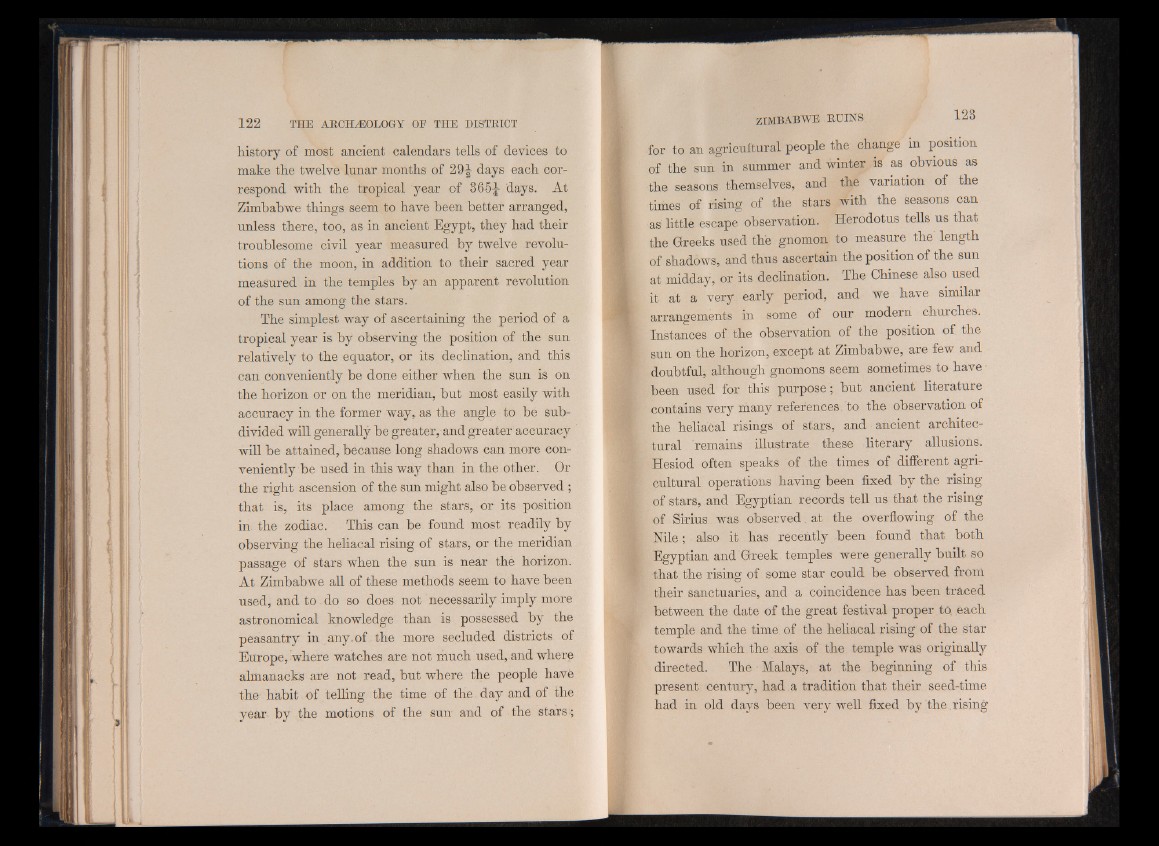
history of most ancient calendars tells of devices to
make the twelve lunar months of 29-J days each correspond
with the tropical year of 365J days. At
Zimbabwe things seem to have been better arranged,
unless there, too, as in ancient Egypt, they had their
troublesome civil year measured by twelve revolutions
of the moon, in addition to their sacred year
measured in the temples by an apparent revolution
of the sun among the stars.
The simplest way of ascertaining the period of a
tropical year is by observing the position of the sun
relatively to the equator, or its declination, and this
can conveniently be done either when the sun is on
the horizon or on the meridian, but most easily with
accuracy in the former way, as the angle to be subdivided
will generally be greater, and greater accuracy
will be attained, because long shadows can more conveniently
be used in this way than in the other. Or
the right ascension of the sun might also be observed ;
that is, its place among the stars, or its position
in the zodiac. This can be found most readily by
observing the heliacal rising of stars, or the meridian
passage of stars when the sun is near the horizon.
At Zimbabwe all of these methods seem to have been
used, and to do so does not necessarily imply more
astronomical knowledge than is possessed by the
peasantry in any.of the more secluded districts of
Europe, where watches are not much used, and where
almanacks are not read, but where the people have
the habit of telling the time of the day and of the
year by the motions of the sun and of the stars-;
for to an agricultural people the change in position
of the sun in summer and winter is as obvious as
the seasons themselves, and the variation of the
times of rising of the stars with the seasons can
as little escape observation. Herodotus tells us that
the Greeks used thè gnomon to measure the length
of shadows, and thus ascertain the position of the sun
at midday, or its declination. The Chinese also used
it at a very early period, and we have similar
arrangements in some of our modern churches.
Instances of the observation of the position of the
sun on the horizon, except at Zimbabwe, are few and
doubtful, although gnomons seem sometimes to have-
been used for this purpose ; but ancient literature
contains very many references, to the observation of
the heliacal risings of stars, and ancient architectural
remains illustrate these literary allusions.
Hesiod often speaks of the times of different agricultural
operations having been fixed by the rising
of stars, and Egyptian records tell us that the rising
of Sirius was observed at the overflowing of the
Nile ; also it has recently been found that both
Egyptian and Greek temples were generally built so
that the rising of some star could be observed from
their sanctuaries, and a coincidence has been traced
between the date of the great festival proper to. each
temple and the time, of the heliacal rising of the star
towards which the axis of the temple was originally
directed. The • Malays, at the beginning of this
present century, had a tradition that their seed-time
had in old days been very well fixed by the rising